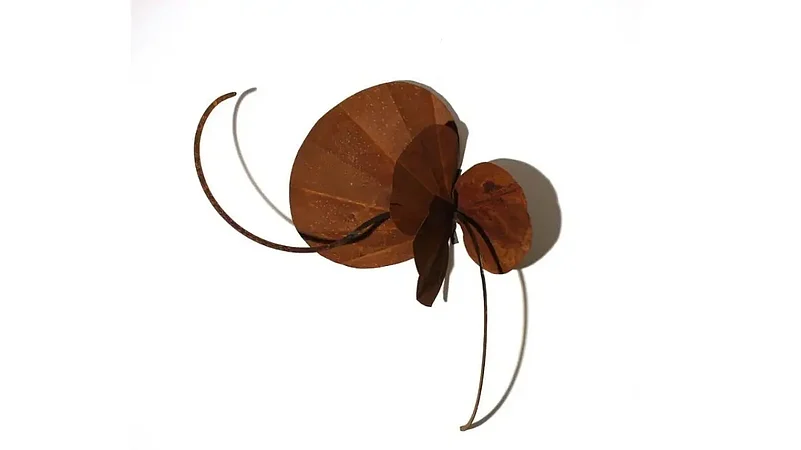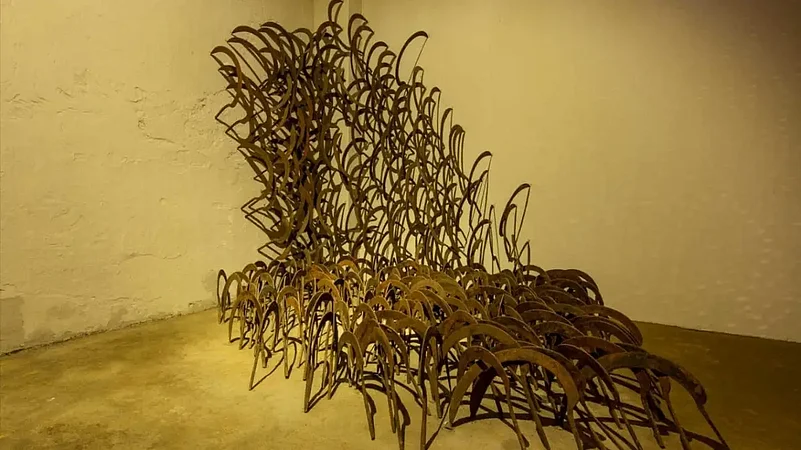If you ever touch a farmer’s sickle and wake up it from its elongated slumber you will know that even metal can be as competent an absorber as a sponge, and the tool is soaked up with the wet soil, dry dust, coarse skin, and the metronome soul of the farmhand, and the lone stars staring at the constellations from outside or the barking dogs half-visible in the sudden flare of some fireflies.
As I talk with Shambhavi Singh about her art forged using sickles (Reaper’s Melody of Kaatani Geet, 2018) or the goddess (Red Kali 2009) or the presence of black and water in her solid artworks my wit whispers to me that I finally met an artist whose art inhales and exhales, is micro and macro at once, and steps inside my mind with its feet unwashed, unashamed of the dirt and dust it brings in. She is a born storyteller and imparts her tale the way the men closer to the earth have been chronicling for thousands of years. If her story follows the oral tradition, although the elements are as recent as her own childhood, her art reflects the power and symbolism of the cave paintings of Altamira and Bhimbetka.
Advertisement
She tells me, because we are surrounded by rain today and because I feel the overlayer of black hues in her works must have a background story, about the 1975 Bihar flood. A good part of the state was on the roofs grasping for life or submerged under the muddy and choking water. She was with her family on top of their flat roof, fortunate enough to own a three-story building. The ground floor was liquid. Their neighbors, all on their respective roofs, listen to the radio. Indira Gandhi was the Prime Minister. She would fly over the affected areas. Shambhavi Singh was only in her adolescence and yet the memory rivulets as strong as the Sone river on that day. She tells me that when Mrs Gandhi flew over their roofs suddenly, people on the roofs all waved black cloths at the plane. They did not have flags of protest. They used any fragment of black fibers they could lay their hands on, and the incident was simultaneous, silent, and unprovoked as if this was a successful experiment of the Jungian collective unconscious. Rain hissed around them.
Advertisement
She attended the local College of Fine Arts and Crafts, Patna in the 1980s. She is glad that she went there because two years later her beloved father departed. The first thing she saw setting foot on her college promises was the writings on the boundary wall, broken by the same flood. The hues were yellow ochre and bright blue. If she can still recall those bright colors, I think, her color black is like an ancient veil, transparent, translucent, through which we must see the light, forms, and shapes, both real and surreal. Is not that way a dream works?

Shambhavi Singh tells me about the lessons of the college, mostly technical, which filled up her days. Where would an artist gather more elements to b added to her soul, but by sneaking out at night, sitting by the trees, gossiping with her friends, or staring at the wind, stars, and water, all black and yet very decipherable? Her childhood train passed the great bridge over the river Sone, again and again, mostly during the nights. I can see the river in her work and her words, its water passing the bogies of the carriage from ripples to ripples.
Advertisement
She builds pale nights, cold and misty, and she builds it with the clarity of one who remembers her roots and with the warmth of the very woman who conceives the world.
You should look at her painting called Red Kali (2009). Shambhavi Singh’s artwork interns Shakti in a triangular torso-shaped abstract, and in red on the dark maroon backdrop the art is seraphic, and she belongs to this soil. If you fail to perceive her you succeed in understanding her. Remember Ramkrishna. Mother does not belong to anyone alone.
We talk about the sickles again. In 'Kaatani Geet', the metal plays an arpeggio, morphs into a murder of crows, and flies into the sky before disappearing through one point of oblivion. Shambhavi tells me that in the case of a village hard worker their house is like a membrane between the outside and the inside. Their outside is not very unlike their inside. A city-dwelling keeps the outside out there. I told her she should begin a podcast. Her stories shall inspire a new generation of artists searching for art in terms of market or technique.
Advertisement
Does her art absorb something from her later life? She chuckled, her childhood memories were revived after one day when a writer friend silently nudged her towards 'The God of Small Things' by Arundhati Roy. Certain phrases and words of the book opened the gate of remembrance and roots. And she kept it open.




















